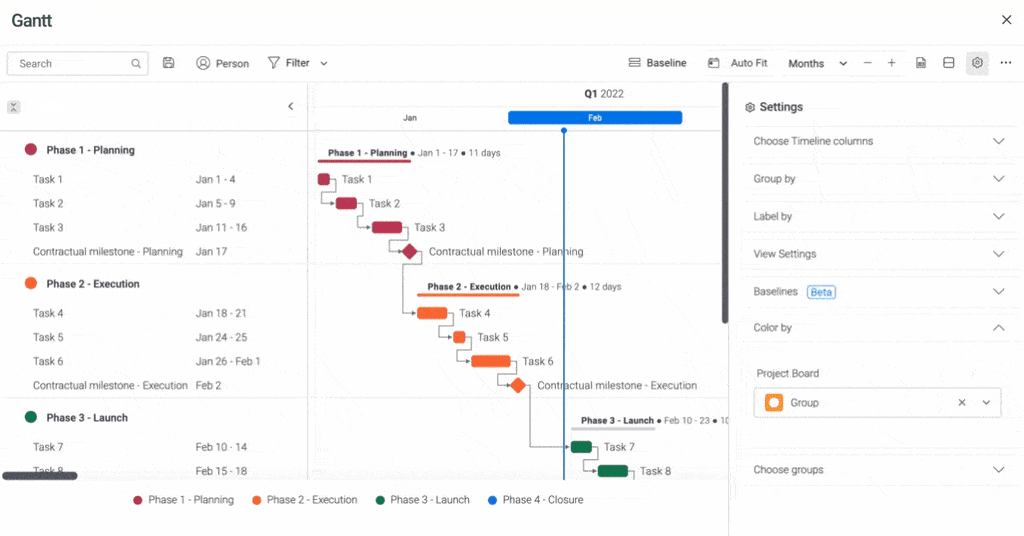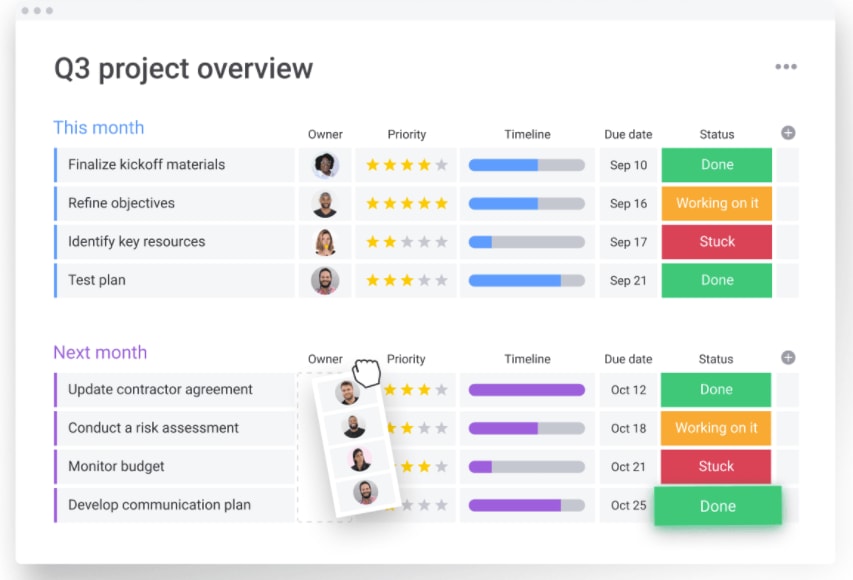The beginners guide to critical chain project management
Blog: Monday Project Management Blog
A failed project usually boils down to a handful of things: Being late, over budget, and below specification and quality. And one major failure factor is resource issues — specifically misuse or simply running out of them. This alone forces businesses to suffer from all three of the issues mentioned above. If there’s one silver bullet to stop this happening, it’s implementing critical chains.
So what exactly is a critical chain, and how does it help achieve project management success?
Let’s find out. Starting with a quick definition.
“Critical chain” is a part of our Project Management Glossary — check out the full list of terms and definitions.
What is a critical chain in project management?
A critical chain is a project management methodology that aims to help you complete tasks as efficiently as possible.
A brief history: Based on Dr. Eliyahu M. Goldratt’s theory of constraints (developed in the 90s), the critical chain methodology challenges traditional project management practices that can actually cause blockers — like multitasking. Instead, it focuses on new techniques like using project buffers, improved communication and correct measurement.
Sound familiar? You might see this technique in world-leading project management approaches today.
With critical chains, you can focus on finding the bottlenecks or limiting factors that can be the sole reason a business misses a project deadlines. The methodology heavily focuses on monitoring the use of resources — like materials and labour.
The benefits?
Here are just a handful of ways critical chains help:
- Outline task dependencies and resource constraints
- Establish an ideal project workflow – and plan A, B or C backup workflows
- Add extra resources to the project (but only if required)
To sum up: With all this in place, you can track progress based on whether or not you are using all available resources. And where resources could create a bottleneck.
Confused by the difference between a critical chain and a critical path? This next section is for you.
What is the difference between a critical path and a critical chain?
There’s one major difference between a critical path and a critical chain. Critical paths look at all the workstreams involved in completing a project. A critical chain then hones in on which of these workstreams is absolutely essential for a project to successfully be completed. For example, resources required.
📕Want to learn more about critical paths? Check out this blog.
This helps project teams to prioritize workflows and tasks.
Now, let’s look at one specific project management example that Goldratt deems a major no-no.
Critical chain deep dive: The illusion of multitasking
Contrary to what we’d expect, multitasking is the single best way to screw up two or more tasks.
Why? Because:
- It slows everything down
- It reduces quality
- It wastes time and costs more
- It is bad for morale
- It complicates scheduling and control
- It removes planning predictability
- It causes delivery delays.
So how do savvy businesses manage multiple work streams efficiently?
This is exactly where critical chain project management comes in. It allows businesses to focus on single tasking with good measures and visible control.
The new way: single tasking – One task worked on at a time. No interruptions. Dedicated work until complete. It improves quality, reduces time and money, simplifies scheduling and control and enables planning predictability. What’s more, it’s good for morale and speeds everything up.
Let’s look a how single tasking fits within a critical chain process.
How to use a critical chain in project management
Here are the basic steps businesses can follow to get started with critical chains.
Step 1: Identify the critical chain – Once you’ve mapped all the work streams involved in the project, highlight THE most critical work streams and tasks (hint: resources).
Step 2: Determine the exact resources needed – For example, look at the materials, tools, labour and specialist skills.
Step 3: Flag resource constraints – By flagging these early, businesses are more likely to hit the big deadline. Are particular team members planning holidays? Will there be a surge in demand for particular materials?
Step 4: Focus teams on tasks – As we’ve covered, multitasking is an efficiency no-no. Use your critical chain to identify key tasks and focus teams on fewer items at a time.
Step 5: Prepare your buffers – Some tasks will need a sort of shock absorber buffer as tasks inevitably will take longer than expected. A good rule of thumb is to allow 50% more time for the likely bottlenecks.
Step 6: Create a detailed plan – Using all the above, you can create a model that visually shows the tasks, time estimates, task descriptions, resources assigned, buffers and finish dates.
Step 7: Prepare good measures and visible control: With critical chain methodology progress reporting is daily, you report if a task is complete, and if not, how much task-time is left remaining? This allows you to add contingency buffers (if required).
Want to implement critical chains the easy way? Lean on clever tech.
Control your critical chain with a Work OS platform
Focusing on the resources needed to complete a project allows project managers (PMs) to create a process that is much simpler and easier to manage. With monday.com Work OS, this is a doddle.
Built specifically for PMs, our platform allows teams to visualize the entire project lifecycle — including dependencies, timelines, tasks allocated by individuals and so much more.
Here are just a couple of examples to show you how…
Quick example #1: Visualize timelines.
And if a flow chart or Gantt chart doesn’t work for you, take a look at some other templates. There are plenty of options out there for you to choose from.

Quick example #2: Prioritize and order tasks.

Still looking for answers? Take a look at these commonly asked questions.
Frequently Asked Questions
What is the meaning of critical chain?
In project management, a critical chain helps businesses better plan and manage the resources that are essential to completing project tasks… This ultimately allows businesses to keep on track with projects and hit the deadline.
What is the focus of the critical chain?
The main aim of a critical chain? To prevent resource issues, like misuse or simply running out of them, from impacting project deadlines, budget or quality.
Basically, with a critical chain, businesses create contingency plans and buffers to prevent resource being an issue.
What is the difference between the critical path and the critical chain?
A critical path covers multiple work streams that are needed to complete a project. Whereas, the critical path focuses on the most crucial tasks, like resources. This helps project teams to prioritize workflows and tasks.
Finish what you started with critical chains
The bottom line? Critical chain project management provides the opportunity to plan projects well for maybe the very first time.
The key is to break with old traditions of how you did things in the past, and reorganize the way you plan projects.
But planning is only half the story. The real power of this approach comes when you have the right platform behind you. Daily task status alerts help you to stay on track without relying on people to email in or attend regular meetings.
Final tips:
- Implement the right Work OS platform – but don’t just rely on this!
- Often needs considerable cultural changes – people need to get used to new working methods.
- Start with a pilot scheme
- Then progress to multi-project
The post The beginners guide to critical chain project management appeared first on monday.com Blog.
Leave a Comment
You must be logged in to post a comment.








